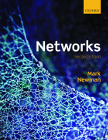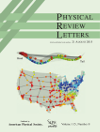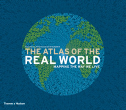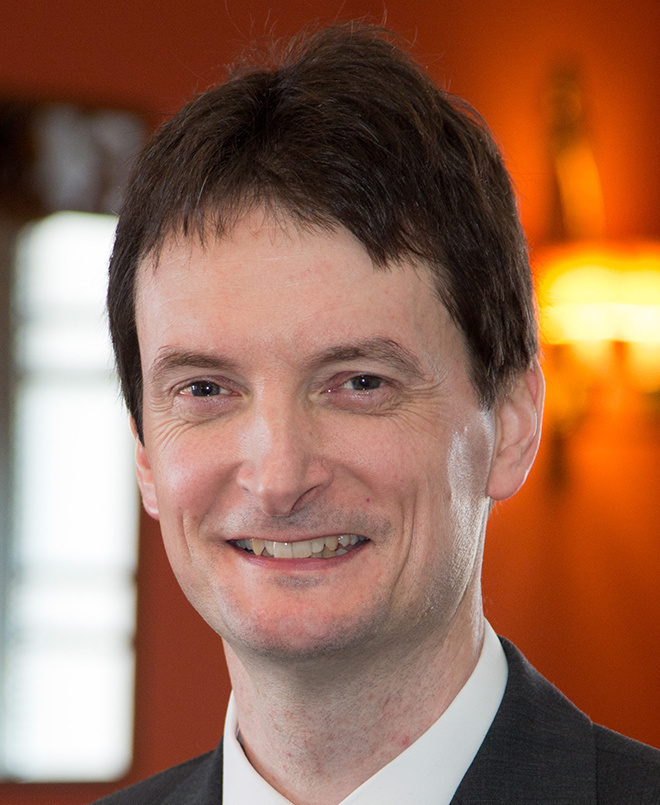Our group conducts research on the structure and function of networks, particularly social and information networks, which we study using a combination of empirical methods, analysis, and computer simulation. Among other things, we have investigated scientific coauthorship networks, citation networks, email networks, friendship networks, epidemiological contact networks, and animal social networks; we've studied fundamental network properties such as degree distributions, centrality measures, vertex similarity, community structure, and assortative mixing, and made analytic or computer models of disease propagation, friendship formation, the spread of computer viruses, the Internet, and network navigation.
Information
Selected publications:
- Random graphs with
arbitrary degree distributions and their applications, M. E. J. Newman,
S. H. Strogatz, and D. J. Watts, Phys. Rev. E 64, 026118
(2001).
- The structure
of scientific collaboration networks, M. E. J. Newman,
Proc. Natl. Acad. Sci. USA 98, 404-409 (2001).
- Assortative mixing in
networks, M. E. J. Newman, Phys. Rev. Lett. 89, 208701
(2002).
- The structure and
function of complex networks, M. E. J. Newman, SIAM Review
45, 167-256 (2003).
- Modularity and
community structure in networks, M. E. J. Newman,
Proc. Natl. Acad. Sci. USA 103, 8577-8582 (2006).
- Hierarchical structure and the
prediction of missing links in networks, A. Clauset, C. Moore,
and M. E. J. Newman, Nature 453, 98–101 (2008).
- Power-law distributions in
empirical data, Aaron Clauset, Cosma Rohilla Shalizi, and
M. E. J. Newman, SIAM Review 51, 661-703 (2009).
- Graph spectra and the
detectability of community structure in networks, Raj Rao
Nadakuditi and M. E. J. Newman, Phys. Rev. Lett. 108, 188701
(2012).
- Percolation on sparse
networks, Brian Karrer, M. E. J. Newman, and Lenka Zdeborová,
Phys. Rev. Lett. 113, 208702 (2014).
- Structure and inference in annotated networks, M. E. J. Newman and Aaron Clauset,
Nature Communications 7, 11863 (2016).
- Aspirational pursuit of mates in online dating markets, Elizabeth E. Bruch and M. E. J. Newman, Science Advances 4, eaap9815 (2018).
- Network structure from rich but noisy data, M. E. J. Newman, Nature Physics 14, 542-545 (2018).
- Message passing on networks with loops, George T. Cantwell and M. E. J. Newman, Proc. Natl. Acad. Sci. USA 116, 23398–23403 (2019).
- Efficient computation of rankings from pairwise comparisons, M. E. J. Newman, Journal of Machine Learning Research 24, 238 (2023).
- Luck, skill, and depth of competition in games and social hierarchies, Maximilian Jerdee and M. E. J. Newman, Science Advances 10, eadn2654 (2024).
Research group
-
Group members:
- PI: Professor Mark Newman
- Galen Hall, PhD student
- Connie Sheeran, PhD student
- Former group members:
- Dr. Brian Ball, Dotomi Inc.
- Professor George Cantwell, Cambridge University
- Professor Michael Gastner, Singapore Institute of Technology
- Professor Gourab Ghoshal, University of Rochester
- Professor Michelle
Girvan, University of Maryland
- Professor Petter Holme, Aalto University
- Dr. Maximilian Jerdee, Santa Fe Institute
- Dr. Brian Karrer, Facebook Corporation
- Professor Alec Kirkley, University of Hong Kong
- Dr. Elizabeth Leicht, Oxford University
- Dr. Travis Martin, Google Inc.
- Professor Juyong Park, KAIST, Seoul
- Professor Bethany Percha, Mount Sinai School of Medicine
- Dr. Austin Polanco, Accrete AI Inc.
- Dr. Maria Riolo, Santa Fe Institute
- Professor Jean-Gabriel Young, University of Vermont
- Dr. Xiao Zhang,
Amazon A9 Inc.
Courses
Previous courses:
- Physics 288, Physics of Music, Winter 2025
- Complex Systems 335, Network Science, Fall 2024
- Physics 288, Physics of Music, Winter 2024
- Complex Systems 535, Network Theory, Fall 2023
- Physics 288, Physics of Music, Winter 2022
- Complex Systems 535, Network Theory, Fall 2021
- Physics 288, Physics of Music, Winter 2021
- Complex Systems 535, Network Theory, Fall 2020
- Physics 288, Physics of Music, Winter 2020
- Complex Systems 535, Network Theory, Fall 2019
- Physics 411, Computational Physics, Winter 2019
- Complex Systems 535, Network Theory, Fall 2018
- Physics 411, Computational Physics, Winter 2018
- Complex Systems 535, Network Theory, Fall 2017
- Physics 411, Computational Physics, Winter 2017
- Complex Systems 535, Network Theory, Fall 2015
- Physics 390, Introduction to Modern Physics, Winter 2015
- Complex Systems 535, Network Theory, Fall 2014
- Physics 411, Computational Physics, Winter 2014
- Complex Systems 535, Network Theory, Fall 2013
- Physics 411, Computational Physics, Winter 2013
- Complex Systems 535, Network Theory, Fall 2012
- Physics 411, Computational Physics, Winter 2012
- Complex Systems 535, Network Theory, Fall 2011
- Physics 411, Computational Physics, Winter 2011
- Complex Systems 535, Network Theory, Fall 2010
- Physics 390, Introduction to Modern Physics, Winter 2010
- Complex Systems 535, Network Theory, Fall 2009
- Physics 390, Introduction
to Modern Physics, Winter 2008
- Complex Systems 511,
Theory of Complex Systems, Fall 2007
- Physics 406, Statistical
and Thermal Physics, Winter 2007
- Complex Systems 899,
Theory of Complex Systems, Winter 2006
- Complex Systems 535, Network
Theory, Winter 2005
- Physics 406, Statistical
and Thermal Physics, Fall 2004
- Complex Systems 535, Network
Theory, Winter 2004
- Physics 406, Statistical
and Thermal Physics, Fall 2003
- Physics 406, Statistical
and Thermal Physics, Fall 2002
Other information
 The second edition of my book Computational Physics has just appeared in print. More information, along with some sample chapters, can be found here. The Amazon page is also a good place to look for info.
The second edition of my book Computational Physics has just appeared in print. More information, along with some sample chapters, can be found here. The Amazon page is also a good place to look for info.
 My book The Science of Music was published in 2024. It is about the physics and broader science of music, including the physics of sound, acoustics, hearing, music technology, and the design and function of musical instruments. More information, along with some sample chapters, can be found here.
My book The Science of Music was published in 2024. It is about the physics and broader science of music, including the physics of sound, acoustics, hearing, music technology, and the design and function of musical instruments. More information, along with some sample chapters, can be found here.
 The second edition of my book
Networks is now available from Oxford University Press. Information about it is here. The Amazon
page is also a good place to look for info.
The second edition of my book
Networks is now available from Oxford University Press. Information about it is here. The Amazon
page is also a good place to look for info.
 Our work on generalized communities in networks was featured on the cover of
Physical Review Letters.
Our work on generalized communities in networks was featured on the cover of
Physical Review Letters.
 With Daniel Dorling and Anna
Barford: The Atlas of the Real
World, a popular book containing 366 cartograms showing all kinds of different features of the world today.
With Daniel Dorling and Anna
Barford: The Atlas of the Real
World, a popular book containing 366 cartograms showing all kinds of different features of the world today.
 Our work on
density-equalizing map projections appeared on the cover of the
Proceedings of the National Academy of Sciences.
Our work on
density-equalizing map projections appeared on the cover of the
Proceedings of the National Academy of Sciences.
Contact details:
I am not the only professor called Mark Newman at the University of
Michigan. I'm the physicist who works on networks. There is another Mark
Newman in the UM School of Information who works on human-computer
interaction.
Here are my contact details:
Department of Physics
University of Michigan
Randall Laboratory
450 Church Street
Ann Arbor, MI 48109-1040
Phone: (734) 764-4437
Email: mejn@umich.edu
Last modified: August 29, 2025
Mark Newman, Department of Physics, University of Michigan


 The second edition of my book Computational Physics has just appeared in print. More information, along with some sample chapters, can be found here. The Amazon page is also a good place to look for info.
The second edition of my book Computational Physics has just appeared in print. More information, along with some sample chapters, can be found here. The Amazon page is also a good place to look for info.
 My book The Science of Music was published in 2024. It is about the physics and broader science of music, including the physics of sound, acoustics, hearing, music technology, and the design and function of musical instruments. More information, along with some sample chapters, can be found here.
My book The Science of Music was published in 2024. It is about the physics and broader science of music, including the physics of sound, acoustics, hearing, music technology, and the design and function of musical instruments. More information, along with some sample chapters, can be found here.
 The second edition of my book
Networks is now available from Oxford University Press. Information about it is here. The Amazon
page is also a good place to look for info.
The second edition of my book
Networks is now available from Oxford University Press. Information about it is here. The Amazon
page is also a good place to look for info.
 Our work on generalized communities in networks was featured on the cover of
Physical Review Letters.
Our work on generalized communities in networks was featured on the cover of
Physical Review Letters.
 With Daniel Dorling and Anna
Barford: The Atlas of the Real
World, a popular book containing 366 cartograms showing all kinds of different features of the world today.
With Daniel Dorling and Anna
Barford: The Atlas of the Real
World, a popular book containing 366 cartograms showing all kinds of different features of the world today.
 Our work on
density-equalizing map projections appeared on the cover of the
Proceedings of the National Academy of Sciences.
Our work on
density-equalizing map projections appeared on the cover of the
Proceedings of the National Academy of Sciences.